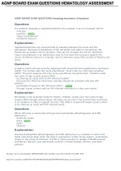-
1. Exam (elaborations) - Med-surg : cardiovascular and hematology study guide 2022
-
2. Exam (elaborations) - Nurs-202 exam 5 - hematology and neuro 2022 exam questions and answers 100% correct
-
3. Exam (elaborations) - Agnp board exam questions hematology assessment.docx
-
4. Exam (elaborations) - Nclex: hematology| 201 questions| with complete solutions| all verified
-
5. Exam (elaborations) - Ascp hematology| 245 questions| with complete solutions
-
6. Exam (elaborations) - Ascp hematology review | 250 questions | 100% correct answers
-
7. Exam (elaborations) - Ascp hematology exam-mlt questions with complete solutions
-
8. Exam (elaborations) - Ascp boc hematology| 81 questions| with complete solutions
-
9. Exam (elaborations) - Hematology ascp boc| 377 questions| with complete solutions
-
10. Exam (elaborations) - Amt certification exam hematology/coagulation
-
11. Exam (elaborations) - Mlt hematology exam 1| 60 questions| with complete solutions
-
12. Exam (elaborations) - Mls boc – hematology| 171 questions| with complete solutions
-
13. Exam (elaborations) - Mls review hematology questions with complete solutions
-
14. Exam (elaborations) - Mls review: immunohematology| 135 questions with complete solutions
-
15. Exam (elaborations) - Ascp mls hematology/coagulation practice questions with complete solutions
-
16. Exam (elaborations) - Mls hematology exam| 263 questions| with complete solutions
-
17. Exam (elaborations) - Pediatrics hematology and oncology exam review questions with complete solutions
-
18. Exam (elaborations) - Ati learning system rn 3.0 med surg cardiovascular and hematology dynamic quiz with c...
-
19. Exam (elaborations) - Hematology mcqs questions with complete solutions
-
20. Exam (elaborations) - Hematology review (quiz questions) with complete solutions
-
21. Exam (elaborations) - Hematology mcqs 2 questions with complete solutions
-
22. Exam (elaborations) - Blood-multiple choice questions-a and p ii-tu s2023 answers with complete solutions
-
23. Exam (elaborations) - Hematology exam questions/review for final questions with complete solutions
-
24. Exam (elaborations) - Hematologic pharmacology questions with complete solutions
-
25. Exam (elaborations) - Patho heme exam| 240 questions| with complete solutions
-
26. Exam (elaborations) - Hematology (ati test/drills/case study/book) questions with complete solutions
-
27. Exam (elaborations) - Nur334 hematology, ati review questions with complete solutions
-
28. Exam (elaborations) - Hematology study questions with complete solutions
-
29. Exam (elaborations) - Hematology questions and answers with complete solutions
-
30. Exam (elaborations) - Hematology dx methods questions with complete solutions
-
31. Exam (elaborations) - Hematology exam #1(mls 325 und hem lectures 1-10) questions with complete solutions
-
32. Exam (elaborations) - Blood disorders hematology questions with complete solutions
-
33. Exam (elaborations) - Hematology - boc mult choice coagulation and hemostasis (navy mlt phase ii study mate...
-
34. Exam (elaborations) - Immunohematology - test 1(chapters 1 – 3) questions with complete solutions
-
35. Exam (elaborations) - Serology ch 14 questions with complete solutions
-
36. Exam (elaborations) - Hematology review| 130 questions| with complete solutions
-
37. Exam (elaborations) - Blood bank purple book, boc blood bank final, blood banking, lecture 9 (donor process...
-
38. Exam (elaborations) - Test 3 immunology serology grayson college mlt| 177 questions| with complete solution...
-
39. Exam (elaborations) - Hematology lecture notes
-
40. Exam (elaborations) - Ascp hematology review| 250 questions| comprehensive ascp review cards| with complete...
-
41. Exam (elaborations) - Hematology study guide| 75 questions| with complete solutions
-
42. Exam (elaborations) - Ascp boc hematology| 85 questions| with complete solutions
-
43. Exam (elaborations) - Endocrine & hematological emergencies - multiple choice questions with complete solut...
-
44. Exam (elaborations) - Blood multiple choice questions with complete solutions
-
45. Exam (elaborations) - 3. path hematology mcq questions with complete solutions
-
46. Exam (elaborations) - Hematology study questions: set 1 questions with complete solutions
-
47. Exam (elaborations) - Mlt 250 hematology practice exam questions with complete solutions
-
48. Exam (elaborations) - A&p hematology questions with complete solutions
-
49. Exam (elaborations) - Peds hematology practice questions with complete solutions
-
50. Exam (elaborations) - Hematology – nclex questions with complete solutions
-
51. Exam (elaborations) - Aab mt hematology questions and answers to review for the aab mt exam| with complete ...
-
Show more




